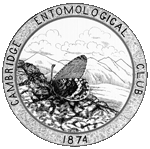
| January 2008: Psyche has a new publisher, Hindawi Publishing, and is accepting submissions |
Notes on Some New England Phyganeidae (Trichoptera).
Psyche 58:20-23, 1951.
Full text (searchable PDF, 252K)
Durable link: http://psyche.entclub.org/58/58-020.html
The following unprocessed text is extracted from the PDF file, and is likely to be both incomplete and full of errors. Please consult the PDF file for the complete article.
NOTES ON SOME NEW ENGLAND PHRYGANEIDAE
(TRICHOPTERA)
BY NATHAN BANKS
Holliston, Mass.
Among the caddice flies taken 'by Prof. Brues at Peters- ham, Mass., and also by the State Forest Service in Maine, there are many specimens of Banksiola. More than half are selina? but many are dossvarkx, and there are (from Peters- ham) six specimens of smithi (both sexes) and two males and two females of cava, previously known to me by only one specimen. Also from various localities there are many canadensis and some of the similar (in appearance) Neu- ronia, ungustipennis.
In B. selina I note that there is much variation in the processes on the hind margin of the genital cavity, and fre- quently the two sides are unlike.
Of the dossuaria, six are from Petersham, the others from Maine; Tim Pond, Holeb, Ashland, Hardwood Mt., Oquos- soc, Camp Colby, Round Mt., Seeboornook. The smithi are all from Petersham, except one from Hol- liston. Leonard has recorded B. smithi from Michigan. The canadensis are mostly from Ashland and Gibson, one Tram- way, Jonesboro, and Kellyland. (These are the ones pinned, others were put in alcohol, and many more discarded, mostly selina.)
In the M.C.Z. collection there is a new species of BcmksioZa from eastern Massachusetts, noticeable for its four sub- equal horns.
Banksiola cornuta, n. sp.
Figures 3, 4, 12, 15, 19
The tip of the abdomen shows four large spines, the upper pair with a double tip, inner edge a little irregular, the lower Published with a grant from the Museum of Comparative Zoology at Harvard College.
20
Pnche 58:20.23 (1051). hup Yipsychu rinclub orgtS8158-020 html
================================================================================
19511 Banks -New England Phryganeidae 21 pair of horns simple, and no teeth along the hind margin of the last abdominal segment. From the side one sees the long upper tooth and the lower, and between is an upward ex- tension of lower part, terminating in a rounded tip, just below the upper horn; this tip is provided with numerous long bristles.
From behind one sees the lower tooth of each side, and between, the inner membrane with a large deep excision, much longer than broad. The apical margin of the last dorsal segment has a row of bristles extending over the median process.
Head and thorax pale yellowish, without dark marks. The basal joint of antennae also pale, but beyond largely black; toward tip the joints are banded. The wings have the yel- lowish tint of B. smithi and B. cava. The fore pair are marked much as in B. selina, but not as heavily, the narrow bands rather further apart, and the two large costal spots toward tip are smaller than usual in selina,, no other large marks; the subcosta near the large spots is curved about as selina. In the hind wing the stigma1 spot is prominent and beyond are some faint irrorations, much as in selina'; more irrorate than in smithi. Length of forewings 12 mm. One male from Cohasset, Mass. 20 June, 1908, Type M.C.Z. no 28,557.
Betten and Mosely in the Walker Trichoptera, 1940, have a Neuronia childrexi (page 90) based on a female without locality. They mention dark marks on vertex and on mesono- turn, while the pronotum is very pale and with pale bristles; the new specimens of B. cava agree closely with this colora- tion. Their figure of the wing is broader than any of the B. cava I have seen, but the figure of the female genitalia is like B. cava. Unless another species is found with the same markings I think B. children! must be B. cava. For my Neuronia canadensis which has the radius not only curved near stigma, but often united to the subcosta for at least a point, I propose a new genus Alleodes (Alleodes ccmadensis). The malle genitalia occupy only the lower half of the tip of the abdomen, and are very different in structure from Banksiola. In Banksiola the head is broader than in
================================================================================
22 Psyche [March
Alleodes, and each hind ocellus about its diameter from the eye; in Alleodes the head not so broad, and the hind ocelli closer to the eyes and look more laterally. The apical area of the wing is proportionally longer in Alleodes than in Banksiola, and some apical veins almost parallel to its fellow. Neuronia angustipennis Hagen
Figures 1, 9, 11
This species is well separated from the usual Neuronia by a much more narrow wing and the details of the male genitalia; the co'stal margin of forewing only very slightly concave. The ocelli are proportionally much further apart than in the other species of Neurok.
I make the new subgenus, Neuronella, for Neuronia angu- stipennis (Neuronella angustipennis.)
Fig. 1. Neuronia angustipennis, side, genitalia. Fig. 2. Banksiola dos- suaria, genitalia, side. Fig. 3. Banksiola cornuta, tip of abdomen, above. Fig. 4. Banksiola cornuta, female, below. Fig. 5. Neuronia angustipennis, female below. Fig. 6. Banksiola cava, female, below, of two specimens. Fig. 7. Banksiola cava, male, tip, above. Fig. 8. Banksiola dossuaria, male, tip, above. Fig. 9. Neuronia angustipennis, male, tip, above. Fig. 10. Banksiola dossuaria, male, dentate processes. Fig. 11. Neuronia angustipennis, margin of last ventral segment. Fig. 12. Banksiola cornuta, from behind. Fig. 13. Banksiola selina, processes on hind margin, Clare Co. Mich.
Fig. 14. AlLwdes canadensis, male above. Fig. 15. Banksioh comuta, side. Fig. 16. Banksiola selina, processes, Tim Pond, Me. Fig. 17. Banksiola selina, processes, Petersham. Fig. 18. Alleodes cana- densis, side of male. Fife. 19. Banksiola cornuta, hind margin from below.
================================================================================
nil,
================================================================================
Volume 58 table of contents